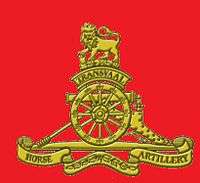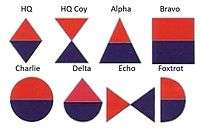Transvaal Horse Artillery
| Transvaal Horse Artillery | |||
|---|---|---|---|
 | |||
| Active | 17 March 1904 to present | ||
| Country |
| ||
| Allegiance | |||
| Branch | |||
| Type | Reserve Artillery | ||
| Part of |
South African Army Artillery Formation Army Conventional Reserve | ||
| Garrison/HQ | Mount Collins, Kelvin, Sandton | ||
| Anniversaries | 17 March 1904 | ||
| Engagements | |||
| Battle honours |
| ||
| Website | Official website | ||
| Commanders | |||
| Officer Commanding | Major A. Pestana | ||
| Insignia | |||
| Collar Badge | Bursting grenade with seven flames | ||
| Beret Colour | Oxford Blue | ||
| Artillery Battery Emblems |
 | ||
| Artillery Beret Bar circa 1992 |
 | ||
The Transvaal Horse Artillery (usually abbreviated to THA) is an artillery regiment of the South African Army. As a reserve unit, it has a status roughly equivalent to that of a British Army Reserve or United States Army National Guard unit. It is part of the South African Army Artillery Formation.
The Transvaal Horse Artillery is currently located in Johannesburg. The main ordnance of the regiment is the G6 self-propelled 155mm gun/howitzer. The THA consists of four batteries: Regimental Headquarters Battery, 7 Battery, 8 Battery and 9 Battery.
History
Origins
The Transvaal Horse Artillery was formed on 17 March 1904 as Lys' Volunteer Corps (after its first commanding officer, Major Godfrey Lys) and was a regiment dependent on horse transport from the start. The regiment's name was changed six months later to the Transvaal Horse Artillery Volunteers, which it retained until 1911, when the present name was adopted.
In 1913, the unit was embodied in the citizen force of the new Union Defence Forces as the 7th Citizen Battery (THA).
World War I
German South-West Africa Campaign
The regiment was part of the Northern Force sent to invade (the then) German South-West Africa at the outbreak World War I. It first saw action in September 1914 at Sandfontein[1] and later distinguished itself at Riet and Namutoni.
Europe
Volunteers from the Transvaal Horse Artillery also later fought as part of the South African Heavy Artillery in Palestine, Egypt and Europe.
Inter-war
In the inter-war period the regiment grew from a single battery to a three battery brigade; it was also mechanised by the introduction of trucks. During the 1922 strike the THA took part in the Battle of Brixton Bridge and in the clearing of Fordsburg.
The unit was renumbered "3rd" in 1926, and reverted to the name Transvaal Horse Artillery in 1932. On the outbreak of World War II in 1939, it became the 3rd Field Brigade (THA).
World War II
During World War II, the THA first saw action against the Italians in Abyssinia.
The regiment's most memorable action during the war was during the battle of Sidi Rezegh in the Western Desert on 23 November 1941. As a part of 5 South African Infantry Brigade Group, the THA suffered considerable losses during heavy action which saw it firing over open sights at the panzers of the Afrika Korps.
After the collapse of Tobruk in June 1942, the regiment lost its headquarters unit as well as its 8th and 9th batteries, except for one troop of 8th Battery. This troop, together with the Coldstream Guards, were the only units to drive out in formation. The remaining (7th) battery of the regiment was first attached to 7 Field Regiment and took part in the fighting at El Alamein in October 1942. It subsequently joined 4/22nd Field Regiment, South African Artillery and saw action throughout the Italian Campaign.
Post-war
From 1960 to 1968, the THA was affiliated to the University of the Witwatersrand and was known as the Witwatersrand University Regiment.
South African Border War
During the post-war period, the regiment was often mobilised with 7 South African Infantry Division's 72 Brigade, to take part in South Africa's Border War, including:
- 1976: In South-West Africa and Angola
- 1979: In South-West Africa during Exercise Eagle Hill, as infantry
- 1981: In Angola during Operation Protea
- 1985: In South-West Africa, again as infantry
Current
The regiment celebrated their 110th Anniversary in 2014.[2]
On 11 June 2007 the THA shared a Royal Salute alongside the HAC at the traditional saluting base, the Tower of London, in honour of the official birthday of the Duke of Edinburgh, Consort to Queen Elizabeth II. It was the first time that any non-Commonwealth troops participated in such an event in the United Kingdom.[2]
On 16 December 2013 the THA had the honour of firing a 21 gun national salute for the president at the official parade to commemorate the Day of Reconciliation and also in honour of the late President Nelson Rohilala Mandela at the occasion of the unveiling of this statue at the Union Buildings.[2]
There is a possibility that the regiment might have to change its name.[3]
Regimental symbols
- Cap badge: a field gun in the centre, with the word "Transvaal" above it and the words "horse artillery" below, with a laurel branch on a curved scroll in between.
- The Transvaal Horse Artillery was formally affiliated with the Honourable Artillery Company from 1937 to 1961 and then again from 1994 to the present.
- The regiment received the Freedom of the City of Johannesburg in 1964.
Battle honours
- South West Africa 1914 - 1915
Alliances
-
 United Kingdom - Honourable Artillery Company
United Kingdom - Honourable Artillery Company
References
- ↑ Warwick, Rodney (28 October 2014). "When South Africa fought the Germans". politicsweb.co.za. PoliticsWeb. Retrieved 29 October 2014.
The two Transvaal Horse Artillery guns uncoupled and swung into action; the white gunners and black auxiliaries demonstrated significant courage in fighting back from such an exposed position with ammunition being rushed across from inconveniently parked munition wagons. A German shell burst killed Battery Sergeant-Major Harris and UDF artillery casualties rose; by noon both guns were out of action.
- 1 2 3 "A hundred and 10 not out for the Transvaal Horse Artillery". defenceweb.co.za. DefenceWEb. 29 April 2014. Retrieved 27 October 2014.
- ↑ Helfrich, Kim (14 June 2013). "No date set for Army Reserve units' name changes". defenceweb.co.za. DefenceWeb. Retrieved 27 October 2014.